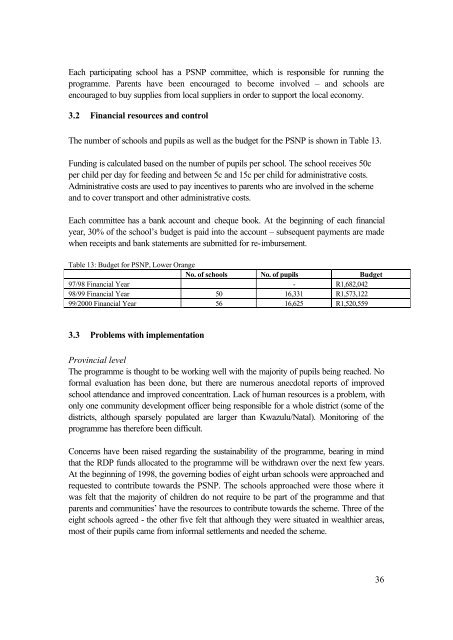Implementing an Integrated Nutrition Programme - Health Systems ...
Implementing an Integrated Nutrition Programme - Health Systems ...
Implementing an Integrated Nutrition Programme - Health Systems ...
Create successful ePaper yourself
Turn your PDF publications into a flip-book with our unique Google optimized e-Paper software.
Each participating school has a PSNP committee, which is responsible for running the<br />
programme. Parents have been encouraged to become involved – <strong>an</strong>d schools are<br />
encouraged to buy supplies from local suppliers in order to support the local economy.<br />
3.2 Fin<strong>an</strong>cial resources <strong>an</strong>d control<br />
The number of schools <strong>an</strong>d pupils as well as the budget for the PSNP is shown in Table 13.<br />
Funding is calculated based on the number of pupils per school. The school receives 50c<br />
per child per day for feeding <strong>an</strong>d between 5c <strong>an</strong>d 15c per child for administrative costs.<br />
Administrative costs are used to pay incentives to parents who are involved in the scheme<br />
<strong>an</strong>d to cover tr<strong>an</strong>sport <strong>an</strong>d other administrative costs.<br />
Each committee has a b<strong>an</strong>k account <strong>an</strong>d cheque book. At the beginning of each fin<strong>an</strong>cial<br />
year, 30% of the school’s budget is paid into the account – subsequent payments are made<br />
when receipts <strong>an</strong>d b<strong>an</strong>k statements are submitted for re-imbursement.<br />
Table 13: Budget for PSNP, Lower Or<strong>an</strong>ge<br />
No. of schools No. of pupils Budget<br />
97/98 Fin<strong>an</strong>cial Year - R1,682,042<br />
98/99 Fin<strong>an</strong>cial Year 50 16,331 R1,573,122<br />
99/2000 Fin<strong>an</strong>cial Year 56 16,625 R1,520,559<br />
3.3 Problems with implementation<br />
Provincial level<br />
The programme is thought to be working well with the majority of pupils being reached. No<br />
formal evaluation has been done, but there are numerous <strong>an</strong>ecdotal reports of improved<br />
school attend<strong>an</strong>ce <strong>an</strong>d improved concentration. Lack of hum<strong>an</strong> resources is a problem, with<br />
only one community development officer being responsible for a whole district (some of the<br />
districts, although sparsely populated are larger th<strong>an</strong> Kwazulu/Natal). Monitoring of the<br />
programme has therefore been difficult.<br />
Concerns have been raised regarding the sustainability of the programme, bearing in mind<br />
that the RDP funds allocated to the programme will be withdrawn over the next few years.<br />
At the beginning of 1998, the governing bodies of eight urb<strong>an</strong> schools were approached <strong>an</strong>d<br />
requested to contribute towards the PSNP. The schools approached were those where it<br />
was felt that the majority of children do not require to be part of the programme <strong>an</strong>d that<br />
parents <strong>an</strong>d communities’ have the resources to contribute towards the scheme. Three of the<br />
eight schools agreed - the other five felt that although they were situated in wealthier areas,<br />
most of their pupils came from informal settlements <strong>an</strong>d needed the scheme.<br />
36
















